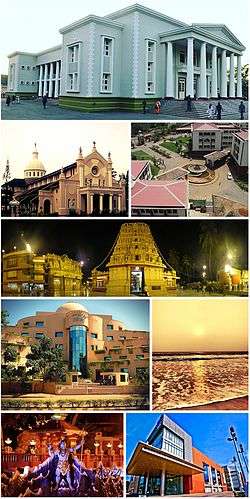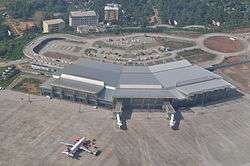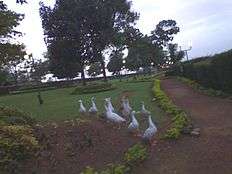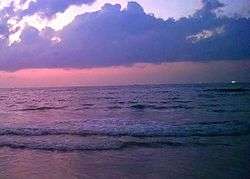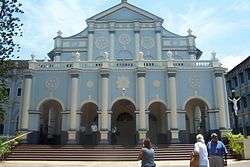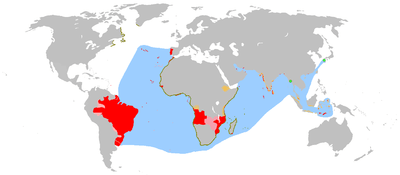Mangalore
| Mangalore ಮಂಗಳೂರು | |
|---|---|
| Corporation City | |
| Mangaluru | |
|
Left to Right: Town Hall, Our Lady of Rosary Church, Yenepoya University, Kudroli Gokarnanatheshwara Temple, Infosys Kottara campus, Tannirbhavi Beach, Shiva statue, Forum Fiza Mall | |
 Mangalore  Mangalore | |
| Coordinates: 12°52′N 74°53′E / 12.87°N 74.88°ECoordinates: 12°52′N 74°53′E / 12.87°N 74.88°E | |
| Country |
|
| State | Karnataka |
| District | Dakshina Kannada |
| Region | Coastal Karnataka |
| Taluk | Mangalore |
| Named for | Mangaladevi |
| Government | |
| • Type | Mayor–Council |
| • Body | Mangalore City Corporation |
| • Mayor | Harinath Jogi |
| • Deputy Mayor | Purushottam |
| • Police Commissioner | M Chandra Sekhar |
| Area | |
| • Corporation City | 184.45 km2 (71.22 sq mi) |
| Elevation | 22 m (72 ft) |
| Population (2011) | |
| • Corporation City | 499,487[1] |
| • Metro | 623,841[2] |
| Demonym(s) | Mangalorean, Kuḍladar, Maṅgaḷūrinavaru, Koḍiyāḷchiṁ |
| Language | |
| • Administrative | Kannada, English |
| • Regional | Tulu, Konkani, Beary, Koraga, Havyaka Kannada |
| Time zone | IST (UTC+5:30) |
| PIN | 575001 to 575030[3] |
| Telephone code | +91-(0)824 |
| Vehicle registration | KA-19, KA-62 |
| Sex ratio | 1016 [1] |
| Human Development Index |
very high |
| Literacy | 94.03%[5] |
| Website |
www |
Mangalore (/ˈmæŋɡəlɔːr/), now officially known as Mangaluru,[6][7] is the chief port city of the Indian state of Karnataka. It is known as Kudla in Tulu, Mangaluru in Kannada, Kodial in Konkani, Maikāla in Beary. It is located about 352 kilometres (220 mi) west of the state capital, Bangalore between the Arabian Sea and the Western Ghat mountain ranges. It is the administrative headquarters of the Dakshina Kannada (formerly South Canara) district in south western Karnataka.
It developed as a port on the Arabian Sea—remaining, to this day, a major port of India. Lying on the backwaters of the Netravati and Gurupura rivers, Mangalore is often used as a staging point for sea traffic along the Malabar Coast. The city has a tropical climate and lies in the path of the Arabian Sea branch of the South-West monsoons. Mangalore's port handles 75 per cent of India's coffee and cashew exports.[8] Mangalore was ruled by several major powers, including the Kadambas, Alupas, Vijayanagar Empire, Keladi Nayaks and the Portuguese. The city was a source of contention between the British and the Mysore rulers, Hyder Ali and Tipu Sultan. Eventually annexed by the British in 1799, Mangalore remained part of the Madras Presidency until India's independence in 1947. The city was unified with the state of Mysore (now called Karnataka) in 1956.[9]
Mangalore is the largest city in Dakshina Kannada district and is one of the most cosmopolitan non-metro cities of India. It is also the largest city in the Coastal and Malnad regions of Karnataka, besides being a leading commercial, industrial, educational and healthcare hub on the West Coast. Mangalore city urban agglomeration extends from Ullal in the south to Mulki in the north, covering a distance of over 40 km. The city's landscape is characterised by rolling hills, coconut palms, freshwater streams and hard red-clay tiled-roof buildings.[10]
Mangalore ranks amongst the cleanest cities in India.[11][12][13][14] The city was ranked India's 13th and Karnataka's second most favourable destination for business.[15] Mangalore will be developed as a smart city under PM Narendra Modi's flagship Smart Cities Mission.[16]
Etymology
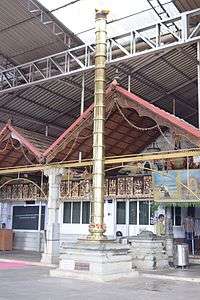
Mangalore was named after the Hindu deity Mangaladevi, the presiding deity of the Mangaladevi temple[17] or a synonym of Tara Bhagvati of the Vajrayana Buddhist sect.[18] According to local legend, a princess from Malabar named Parimala or Premaladevi renounced her kingdom and became a disciple of Matsyendranath, the founder of the Nath tradition. Having converted Premaladevi to the Nath sect, Matsyendranath renamed her Mangaladevi. She arrived in the area with Matsyendranath, but had to settle near Bolar in Mangalore as she fell ill on the way. Eventually she died, and the Mangaladevi temple was consecrated in her honour at Bolar by the local people after her death.[19] The city got its name from the temple.[20]
One of the earliest references to the city's name was made in 715 CE by the Pandyan King Chettian, who called the city Mangalapuram. The city and the coastal region was a part of the Pandyan Kingdom.[21] According to K.V. Ramesh, President of the Place Names Society of India, Mangaluru was first heard in 1345 CE during the Vijayanagar rule. Many shilashasanas (stones) of Vijayanagar period refer the city as Mangalapura. Even before that, during the Alupas period, it was referred to as Mangalapura('Mangala' means 'auspicious'). The city is well known as Mangaluru in Kannada, a reference to Mangaladevi (the suffix uru means town or city). During the British occupation from 1799, Mangalore (anglicised from Mangaluru), stuck as the official appellation.[22] However, according to historian George M. Moraes, the word "Mangalore" is the Portuguese corruption of Mangaluru.[23]:2 The name of this town also appears in maps as early as the 1652 Sanson Map of India.[24] i
Mangalore's diverse communities have different names for the city in their languages. In Tulu, the primary spoken language, the city is called Kuḍla, meaning "junction", since the city is situated at the confluence of the Netravati and Gurupura rivers. In Konkani, Mangalore is referred to as Koḍiyāḷ, while the Beary name for the city is Maikala.[25]
History
Mangalore's historical importance is highlighted by the many references to the city by foreign travellers. During the first century CE, Pliny the Elder, a Roman historian, made references to a place called Nitrias, as a very undesirable place for disembarkation, on account of the pirates which frequent its vicinity,[26] while Greek historian Ptolemy in the second century CE referred to a place called Nitra. Ptolemy's and Pliny the Elder's references were probably made to the Netravati River, which flows through Mangalore.[27] Cosmas Indicopleustes, a Greek monk, in his 6th century work Christian Topography mentions Malabar as the chief seat of the pepper trade, and Mangarouth (port of Mangalore) as one of the five pepper marts which exported pepper.[28][29]
Mangalore is the heart of a distinct multilinguistic—cultural region: South Canara, the homeland of the Tulu-speaking people.[32] In the third century BCE, the town formed part of the Maurya Empire, ruled by the Buddhist emperor, Ashoka of Magadha.[33]:176 From the third century CE to sixth century CE, the Kadamba dynasty, whose capital was based in Banavasi in North Canara, ruled over the entire Canara region as independent rulers.[34] From the middle of the seventh century to the end of the 14th century, the South Canara region was ruled by its own native Alupa rulers. The Alupas ruled over the region as feudatories of major regional dynasties like the Chalukyas of Badami, Rashtrakutas of Manyakheta, Chalukyas of Kalyani, and Hoysalas of Dwarasamudra.[35]:17 During the reign of the Alupa king Kavi Alupendra (c. 1110 – c.1160), the city was visited by the Tunisian Jewish merchant Abraham Ben Yiju, who travelled between the Middle East and India during the 12th century.[36] The Moroccan traveller Ibn Battuta, who had visited the town in 1342, referred to it as Manjarur, and stated that the town was situated on a large estuary, called the "estuary of the wolf," and was the greatest estuary in the country of Malabar.[37][38]:30 By 1345, the Vijayanagara rulers brought the region under their control.[35]:17 During the Vijayanagara period (1345–1550), South Canara was divided into Mangalore and Barkur rajyas (provinces), and two governors were appointed to look after each of them from Mangalore and Barkur. But many times only one governor ruled over both Mangalore and Barkur rajyas, and when the authority passed into the hands of Keladi rulers (c. 1550–1763), they had a governor at Barkur alone.[35]:19 In 1448, Abdur Razzaq, the Persian ambassador of Sultan Shah Rukh of Samarkand, visited Mangalore, en route to the Vijayanagara court.[38]:31 The Italian traveller, Ludovico di Varthema, who visited India in 1506 says that he witnessed nearly sixty ships laden with rice ready for sail in the port of Mangalore.[35]:20
European influence in Mangalore can be traced back to 1498, when the Portuguese explorer Vasco da Gama landed at St Mary's Island near Mangalore.[39] In the 16th century, the Portuguese came to acquire substantial commercial interests in Canara. Krishnadevaraya (1509–1529), the then ruler of the Vijaynagara empire maintained friendly relations with the Portuguese. The Portuguese trade was gradually gathering momentum and they were striving to destroy the Arab and Moplah trade along the coast. In 1524, when Vasco da Gama heard that the Muslim merchants of Calicut had agents at Mangalore and Basrur, he ordered the rivers to be blockaded. In 1526, the Portuguese under the viceroyship of Lopo Vaz de Sampaio took possession of Mangalore. The coastal trade passed out of Muslim hands into Portuguese hands.[35]:20 In 1550, the Vijayanagara ruler, Sadashiva Raya, entrusted the work of administering the coastal region of Canara to Sadashiv Nayaka of Keladi. By 1554, he was able to establish political authority over South Canara. The disintegration of the Vijaynagara Empire in 1565 gave the rulers of Keladi greater power in dealing with the coastal Canara region.[35]:27 They continued the Vijayanagara administrative system. The two provinces of Mangalore and Barkur continued to exist. The Governor of Mangalore also acted as the Governor of the Keladi army in his province.[35]:30 In 1695, the town was torched by Arabs in retaliation to Portuguese restrictions on Arab trade.[40]
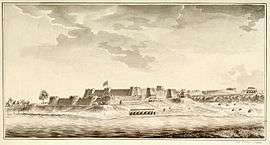
Hyder Ali, the de facto ruler of the Kingdom of Mysore, conquered Mangalore in 1763,[41] consequently bringing the city under his administration until 1767. Mangalore was ruled by the British East India Company from 1767 to 1783,[42] but was subsequently wrested from their control in 1783 by Hyder Ali's son, Tipu Sultan; who renamed it Jalalabad.[43][44] The Second Anglo–Mysore War ended with the Treaty of Mangalore, signed between Tipu Sultan and the British East India Company on 11 March 1784.[45] After the defeat of Tipu at the Fourth Anglo–Mysore War, the city remained in control of the British, headquartering the Canara district under the Madras Presidency.[22][46][47]
According to the Scottish physician Francis Buchanan who visited Mangalore in 1801, Mangalore was a rich and prosperous port with flourishing trading activity.[48] Rice was the grand article of export, and was exported to Muscat, Bombay, Goa and Malabar. Supari or Betel-nut was exported to Bombay, Surat and Kutch. Pepper and Sandalwood were exported to Bombay. Turmeric was exported to Muscat, Kutch, Surat and Bombay, along with Cassia Cinnamon, Sugar, Iron, Saltpeter, Ginger, Coir and Timber.[48]
The British colonial government did not support industrialisation in the region, and local capital remained invested mostly in land and money lending, which led to the later development of banking in the region. With the arrival of European missionaries in the early 19th century, the region saw the development of educational institutions and a modern industrial base, modelled on European industries. The opening of the Lutheran Swiss Basel Mission in 1834 was central to the industrialisation process. Printing press, cloth-weaving mills and tile factories manufacturing the famed Mangalore tiles were set up by the missionaries.[32] When Canara (part of the Madras Presidency until this time) was bifurcated into North Canara and South Canara in 1859, Mangalore was transferred into South Canara and became its headquarters.[50]:5 South Canara remained under Madras Presidency, while North Canara was detached from Madras Presidency and transferred to Bombay Presidency in 1862.[50]:6 The enactment of the Madras Town Improvement Act (1865) mandated the establishment of the Municipal council on 23 May 1866, which was responsible for urban planning and providing civic amenities.[23]:178 The Italian Jesuits, who arrived in Mangalore in 1878, played an important role in education, economy, health, and social welfare of the city.[51] The linking of Mangalore in 1907 to the Southern Railway, and the subsequent proliferation of motor vehicles in India, further increased trade and communication between the city and the rest of the country.[52] By the early 20th century, Mangalore had become a major supplier of educated manpower to Bombay, Bangalore, and the Middle East.[32]
As a result of the States Reorganisation Act (1956), Mangalore (part of the Madras Presidency until this time) was incorporated into the dominion of the newly created Mysore State (now called Karnataka).[9][53]:415 Mangalore is the fourth largest city of Karnataka in terms of population, and eighth largest port of India, providing the state with access to the Arabian Sea coastline.[32] Mangalore experienced significant growth in the decades 1970–80, with the opening of New Mangalore Port in 1974 and commissioning of Mangalore Chemicals & Fertilizers Limited in 1976.[54][55] Today, the Mangalore region is a nationally known higher education hub with a flourishing service sector, particularly in medical services, a small but growing IT regional hub, and a booming real estate and banking industry.[32]
Geography and climate
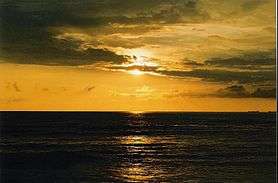

Mangalore is located at 12°52′N 74°53′E / 12.87°N 74.88°E in the Dakshina Kannada district of Karnataka.[56] It has an average elevation of 22 metres (72 ft) above mean sea level.[57] It is the administrative headquarters of the Dakshina Kannada district, the largest urban coastal centre of Karnataka.[58] Mangalore is situated on the west coast of India, and is bounded by the Arabian Sea to its west and the Western Ghats to its east. Mangalore city, as a municipal entity, spans an area of 184.45 km2 (71.22 sq mi).[59] Mangalore experiences moderate to gusty winds during day time and gentle winds at night.[60] The topography of the city is plain up to 30 km (18.64 mi) inside the coast and changes to undulating hilly terrain sharply towards the east in Western Ghats.[61] There are four hilly regions with natural valleys within the city. The geology of the city is characterised by hard laterite in hilly tracts and sandy soil along the seashore.[58] The Geological Survey of India has identified Mangalore as a moderately earthquake-prone urban centre and categorised the city in the Seismic III Zone.[62]
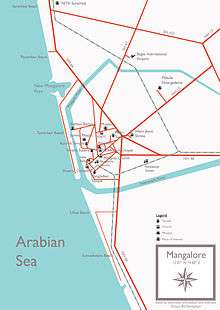
Mangalore lies on the backwaters of the Netravati and Gurupura rivers.[63] These rivers effectively encircle the city, with the Gurupura flowing around the north and the Netravati flowing around the south of the city. The rivers form an estuary at the south-western region of the city and subsequently flow into the Arabian sea.[64] The city is often used as a staging point for traffic along the Malabar Coast. The coastline of the city is dotted with several beaches, such as Mukka, Panambur, Tannirbavi, Suratkal, and Someshwara. Coconut trees, palm trees, and Ashoka trees comprise the primary vegetation of the city.
Under the Köppen climate classification, Mangalore has a tropical monsoon climate and is under the direct influence of the Arabian Sea branch of the southwest monsoon. It receives about 95 per cent of its total annual rainfall within a period of about six months from May to October, while remaining extremely dry from December to March.[65] The average annual precipitation in Mangalore is 3,796.9 millimetres (149 in).[66][67] Humidity is approximately 75 per cent on average, and peaks during May, June and July.[68] The maximum average humidity is 93 per cent in July and average minimum humidity is 56 per cent in January.[68]
The most pleasant months in Mangalore are from December to February, during which time the humidity and heat are at their lowest.[69] During this period, temperatures during the day stay below 30 °C (86 °F) and drop to about 19 °C (66 °F) at night. The lowest recorded temperature at Panambur is 15.6 °C (60 °F) on January 8, 1992, and at Bajpe it is 15.9 °C (61 °F) on November 19, 1974. This season is soon followed by a hot and humid summer, from March to May. In Mangalore, the temperature has never touched 40 °C (104 °F), according to the IMD.[70] The highest ever recorded temperature in Mangalore is 38.1 °C (101 °F) on March 13, 1985.[71][72] The summer gives way to the monsoon season, when the city experiences the highest precipitation among all urban centres in India, due to the influence of the Western Ghats.[73] Rainfall up to 4,000 millimetres (157 in) could be recorded during the period from June to September. The rains subside in September, with the occasional rainfall in October.[74]
The highest rainfall recorded in a 24-hour period is 330.8 millimetres (13 in) on 22 June 2003.[72] In the year 1994, Mangalore received very heavy annual rainfall of 5,018.52 millimetres (198 in).[75]
| Climate data for Mangalore, India | |||||||||||||
|---|---|---|---|---|---|---|---|---|---|---|---|---|---|
| Month | Jan | Feb | Mar | Apr | May | Jun | Jul | Aug | Sep | Oct | Nov | Dec | Year |
| Record high °C (°F) | 36.3 (97.3) |
37.8 (100) |
38.1 (100.6) |
36.6 (97.9) |
36.7 (98.1) |
34.4 (93.9) |
35.5 (95.9) |
32.2 (90) |
34.6 (94.3) |
35.0 (95) |
35.6 (96.1) |
35.6 (96.1) |
38.1 (100.6) |
| Average high °C (°F) | 32.8 (91) |
33.0 (91.4) |
33.5 (92.3) |
34.0 (93.2) |
33.3 (91.9) |
29.7 (85.5) |
28.2 (82.8) |
28.4 (83.1) |
29.5 (85.1) |
30.9 (87.6) |
32.3 (90.1) |
32.8 (91) |
31.5 (88.7) |
| Average low °C (°F) | 20.8 (69.4) |
21.8 (71.2) |
23.6 (74.5) |
25.0 (77) |
25.1 (77.2) |
23.4 (74.1) |
22.9 (73.2) |
23.0 (73.4) |
23.1 (73.6) |
23.1 (73.6) |
22.4 (72.3) |
21.2 (70.2) |
22.9 (73.2) |
| Record low °C (°F) | 16.1 (61) |
17.3 (63.1) |
18.8 (65.8) |
19.7 (67.5) |
20.4 (68.7) |
20.5 (68.9) |
19.8 (67.6) |
19.4 (66.9) |
20.2 (68.4) |
19.1 (66.4) |
15.9 (60.6) |
16.1 (61) |
15.9 (60.6) |
| Average rainfall mm (inches) | 1.1 (0.043) |
0.2 (0.008) |
2.9 (0.114) |
24.4 (0.961) |
183.2 (7.213) |
1,027.2 (40.441) |
1,200.4 (47.26) |
787.3 (30.996) |
292.1 (11.5) |
190.8 (7.512) |
70.9 (2.791) |
16.4 (0.646) |
3,796.9 (149.484) |
| Average rainy days | 0.2 | 0 | 0.3 | 1.6 | 7 | 23.5 | 27.4 | 24.9 | 13.7 | 9.1 | 3.6 | 0.6 | 111.9 |
| Average relative humidity (%) | 62 | 66 | 68 | 71 | 71 | 87 | 89 | 88 | 85 | 79 | 73 | 65 | 75.3 |
| Mean monthly sunshine hours | 313 | 296 | 299 | 292 | 276 | 119 | 94 | 133 | 178 | 226 | 271 | 292 | 2,789 |
| Source #1: India Meteorological Department – Monthly mean maximum & minimum temperature and total rainfall[76] | |||||||||||||
| Source #2: Weather-And-Climate (Humidity and Sunshine hours)[77][78] | |||||||||||||
Economy

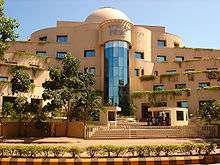

Mangalore's economy is dominated by the industrial, commercial, agricultural processing and port-related activities.[79] One of the largest SEZs in India, the Mangalore Special Economic Zone is in Mangalore. Karnataka's 2nd largest industrial area - Baikampady Industrial Estate is in Mangalore. The New Mangalore Port is India's seventh largest port, in terms of cargo handling. It handles 75 per cent of India's coffee exports and the bulk of its cashew nuts.[8] During 2000–01, Mangalore generated a revenue of ₹33.47 crore (US$4.97 million) to the state.[80] The city's major enterprises include Mangalore Chemicals and Fertilizers Ltd. (MCF), Kudremukh Iron Ore Company Ltd. (KIOCL), Mangalore Refinery and Petrochemicals Ltd. (MRPL), BASF, Bharati Shipyard Limited and Total Oil India Limited (ELF Gas). The leaf spring industry has an important presence in Mangalore, with Canara Workshops Ltd. and Lamina Suspension Products Ltd. in the city.[79] The Baikampady and Yeyyadi Industrial areas harbour several small-scale industries. Imports through Mangalore harbour include crude oil, edible oil, LPG, and timber.[81] The city along with Tuticorin is also one of two points for import of wood to South India.[82]

Major information technology (IT) and outsourcing companies like Infosys, Cognizant Technology Solutions, MphasiS BPO, Thomson Reuters, Endurance International Group have established a presence in Mangalore.[8] Plans to create three dedicated I.T. parks are underway, with two parks (Export Promotion Industrial park (EPIP) at Ganjimutt and Special Economic Zone (SEZ) near Mangalore University) currently under construction.[83] A third IT SEZ is being proposed at Ganjimutt.[84] Another IT SEZ, sponsored by the BA group, is under construction at Thumbe and spans 2 million square feet (180,000 m²).[85] There is an IT Tech Park by the name Soorya Infra tech park situated in Mudipu. It is expected to have many IT companies in future.[86]
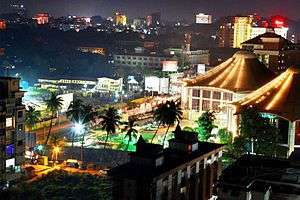
The Oil and Natural Gas Corporation (ONGC) plans to invest over ₹35,000 crore (US$5.20 billion) in a new 15 million tonne refinery, petrochemical plant and power, as well as LNG plants at the Mangalore Special Economic Zone. Indian Strategic Petroleum Reserves Ltd, a special purpose vehicle under the Oil Industry Development Board, is developing strategic crude oil reserves in Mangalore and two other places in India.[87][88] Out of the proposed 5 million metric tonnes (MMT) storage, 1.5 MMT would be at Mangalore.[89] India has built 5.33 million tons of strategic crude oil storages at Mangalore, Padur (near Udupi) in Karnataka and at Visakhapatnam to ensure energy security.[90][91][92] According to an International edition of India Today (28 November – 4 December 2006), Mangalore is the fastest growing non-metro in South India.[93] Corporation Bank,[94] Canara Bank,[95] and Vijaya Bank[96] were the three nationalised banks established in Mangalore during the first half of the 20th century. Karnataka Bank, founded in Mangalore, was one of the largest banks to have not been taken over by the Government.[97] The Mangalore Catholic Co-operative Bank (MCC Bank) Ltd.[98] and SCDCC Bank[99] were the scheduled banks established in Mangalore.The boat building and fishing industry have been core businesses in Mangalore for generations. The Old Mangalore Port is a fishing port located at Bunder in Mangalore, where a large number of mechanised boats anchor.[100] The traffic at this port was 122,000 tonnes during the years 2003–04.[101] The fishing industry employs thousands of people, their products being exported to around the region. Mangalorean firms have a major presence in the tile, beedi, coffee, and cashew nut industry, although the tile industry has declined due to concrete being preferred in modern construction.[8][79] The Albuquerque tile factory in Mangalore is one of India's oldest red roof tile manufacturing factories.[102][103] Cotton industries also flourish in Mangalore. The Ullal suburb of Mangalore produces hosiery and coir yarns, while beedi rolling is an important source of revenue to many in the city.[79] The process of making Mangalore City Corporation into ‘Greater Mangalore’ has almost begun and steps are being initiated to embrace 33 villages around the MCC. In this regard, the meeting of the Gram Panchayat, Town Municipal council and Gram Panchayat Presidents and Secretaries has been convened.[104]
Demographics
Religions in Mangalore city
source:Mangalore City Census 2011 data
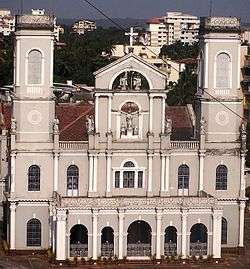
Mangalore city has a population of 684,785 per the 2011 census of India. While the Mangalore city metropolitan area has a population of 684,785 (2011).[105][106] The number of males was 240,651, constituting 50 per cent of the population, while the number of females were 244,134.[107] The decadal growth rate was 45.90.[108] Mangalore has the highest literacy rate in Karnataka. Male literacy was 96.49 per cent, while female literacy was 91.63 per cent.[107] About 8.5 per cent population was under six years of age.[107] Mangalore's literacy rate is 94.03 per cent[107]—significantly higher than the national average of 59.5 per cent.[109] The Human Development Index (HDI) of Mangalore city is 0.83.[4] Birth rate was 13.7 per cent, while death rate and infant mortality rate were at 3.7 per cent and 1.2 per cent respectively.[110] The Mangalore urban area had 32 recognised slums, and nearly 22,000 migrant labourers lived in slums within the city limits.[111][112] According to the Crime Review Report (2006) by the Dakshina Kannada Police, Mangalore registered a drop in the crime rate in 2005, compared with 2003.[113]
The four main languages in Mangalore are Tulu, Kannada, Konkani, and Beary; with Tulu being the mother tongue of the majority.[114] English is also widely spoken in the city. A resident of Mangalore is known as a Mangalorean in English, Kuḍlada in Tulu, Mangalurna in Kannada, Koḍiyāḷci in Goud Saraswat Brahmin Konkani, Koḍiyāḷco in Catholic Konkani and Maikalta in Beary basse.
Hinduism is the majority religion in Mangalore, with Devadiga, Mogaveera, Bunts, Goud Saraswat Brahmins (GSBs), Billavas, Sapaligas, Ganigas, Kota Brahmins, Shivalli Brahmins, Havyaka Brahmins, Sthanika Brahmins, Chitpavan, Brahmin, Kulal's, Gatty's, Koragas are the major communities in Hindus. Christians form a sizeable section of Mangalorean society, with Mangalorean Catholics accounting for the largest Christian community. Protestants in Mangalore typically speak Kannada.[115]
Mangalore has one of the highest percentage of Muslims as compared to other cities in Karnataka. Most Muslims in Mangalore are Bearys, who speak a dialect of Kannada and Tulu called Beary language. Majority of them follow the Shafi'i school of Fiqh(Islamic Jurisprudence).[116]
There is also a small community of local Jains, and Gujarati traders.[32]
Culture
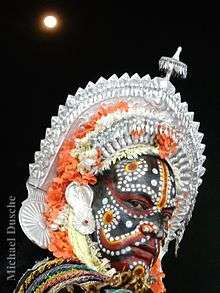

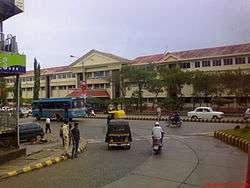
Many classical dance forms and folk art are practised in the city. The Yakshagana, a night-long dance and drama performance, is held in Mangalore,[117] while Pilivesha (literally, tiger dance), a folk dance unique to the city, is performed during Dasara and Krishna Janmashtami.[118] Karadi Vesha (bear dance) is another well known dance performed during Dasara.[119] Paddanas (Ballad-like epics passed on through generations by word of mouth) are sung by a community of impersonators in Tulu and are usually accompanied by the rhythmic drum beats.[119] The Bearys' unique traditions are reflected in such folk songs as kolkai (sung during kolata, a valour folk-dance during which sticks used as props), unjal pat (traditional lullaby), moilanji pat, and oppune pat (sung at weddings).[120] The Evkaristik Purshanv (Konkani: Eucharistic procession) is an annual Catholic religious procession led on the first Sunday of each New Year.[119] The Shreemanti Bai Memorial Government Museum in Bejai is the only museum of Mangalore.[121]
Most of the popular Indian festivals are celebrated in the city, the most important being Dasara, Diwali, Christmas, Easter, Eid, and Ganesh Chaturthi. Kodial Theru, also known as Mangaluru Rathotsava (Mangalore Car Festival) is a festival unique to the Goud Saraswat Brahmin community, and is celebrated at the Sri Venkatramana Temple.[122][123] The Mangalorean Catholics community's unique festivals include Monti Fest (Mother Mary's feast), which celebrates the Nativity feast and the blessing of new harvests.[124] The Jain Milan, a committee comprising Jain families of Mangalore, organises the Jain food festival annually,[125] while festivals such as Mosaru Kudike, which is part of Krishna Janmashtami festival, is celebrated by the whole community.[126] Aati, a festival worshiping Kalanja, a patron spirit of the city, occurs during the Aashaadha month of Hindu calendar. Festivals such as Karavali Utsav and Kudlostava are highlighted by national and state-level performances in dance, drama and music.[127] Bhuta Kola (spirit worship), is usually performed by the Tuluva community at night. Nagaradhane (snake worship) is performed in the city in praise of Naga Devatha (the serpent king), who is said to be the protector of all snakes.[128] An ancient ritual associated with the 'daivasthanams' (temples) in rural areas, Hindu kori katta,[129][130] a religious and spiritual cockfight, is held at the temples and also allowed if organised as part of religious or cultural events.[131]
Civic administration
| Mangalore City officials[132] | |
|---|---|
| Mayor | Harinath Jogi |
| Deputy Mayor | Sumithra Kariya |
| Commissioner of Police | Chandra Shekar |
The Mangalore City Corporation (MCC) is the municipal corporation in charge of the civic and infrastructural assets of the city. Mangalore has the city area of 184.45sqkm. It is the third largest city corporation of Karnataka next to Bangalore and Hubli. Municipal limits begin with Mukka in the north, to Netravati river bridge in the south and western sea shore to Vamanjoor in the east. The MCC council comprises 60 elected representatives, called corporators, one from each of the 60 wards (localities) of the city. Elections to the council are held once every five years, with results being decided by popular vote. A corporator from the majority party is selected as a Mayor.[133] The headquarters of Mangalore City Corporation is at Lalbagh. Its sub-offices are at Surathkal and Bikarnakatta.
Until the revision of Lok Sabha and the legislative constituencies by the Delimitation commission, Mangalore contributed two members to the Lok Sabha, one for the southern part of the city which fell under the Mangalore Lok Sabha Constituency, and another for the northern part of the city which fell under the Udupi Lok Sabha Constituency. Additionally, Mangalore sent three members to the Karnataka State Legislative Assembly. With the revision, the entire Mangalore taluk now falls under the Dakshina Kannada Lok Sabha constituency, resulting in Mangalore contributing only one Member of Parliament (MP).[134][135]
The Mangalore City Police is responsible for the law and order maintenance in Mangalore. The department is headed by a Commissioner of Police. Mangalore is also the headquarters of the Western Range Police, covering the western districts of Karnataka, which is headed by an Inspector General of Police (IGP).[136]
Education

Mangalore is considered as an educational hub of India because students from all over India pursue various professional courses in and around the city adding to its cosmopolitan look and appeal. The pre-collegiate medium of instruction in schools is predominantly English and Kannada, and medium of instruction in educational institutions after matriculation in colleges is English. Additionally, other media of instruction exist in Mangalore. Recently, a committee of experts constituted by the Tulu Sahitya Academy recommended the inclusion of Tulu (in Kannada script) as a medium of instruction in education.[137] Schools and colleges in Mangalore are either government-run or run by private trusts and individuals. The schools are affiliated with either the Karnataka State Board, Indian Certificate of Secondary Education (ICSE), the Central Board for Secondary Education (CBSE) and the National Institute of Open Schooling (NIOS) boards. After completing 10 years of schooling in secondary education, students enroll in Higher Secondary School, specialising in one of the three streams – Arts, Commerce or Science. Since the 1980s, there have been a large number of professional institutions established in a variety of fields including engineering, medicine, homeopathic medicine, dentistry, business management and hotel management. The earliest schools established in Mangalore were the Canara High School (1891), Basel Evangelical School (1838) and Milagres School (1848). The Kasturba Medical College established in 1953, was India's first private medical college.[138] Popular educational institutions in the city are National Institute of Technology (Karnataka), Nitte Education Trust, Srinivas Institute of Technology, Sahyadri Educational Institutions – College of Engineering & Management, Adyar, KS Hegde Medical Academy, A. J. Institute of Medical Science, Father Muller Medical College, Father Muller Homeopathic Medical College, Yenepoya Medical College, Srinivas Medical College, Mangalore Institute of Technology & Engineering (MITE), Bearys Institute of Technology, St. Joseph Engineering College, P.A. College of Engineering, St.Agnes, St. Aloysius College(1879), Sharada Vidyalaya, Alva's Educational Institutions, Canara High School, Canara College, Canara Engineering College, KVG College of Engineering[139] Alvas Education foundation, Dr. M. V. Shetty Institute of Technology, S.D.M. College, Sri Sathya Sai Loka Seva Educational Institutions, Alike[140] and Delhi Public School. A public library run by the Corporation Bank, is located at Mannagudda in Mangalore.[141] Mangalore University was established on 10 September 1980. It caters to the higher educational needs of Dakshina Kannada, Udupi and Kodagu districts[142] and is a National Assessment and Accreditation Council (NAAC) accredited four-star level institution.[143]
Transport

Mangalore's location makes it accessible via all forms of transport – Air, Road, Rail and Sea.[144] Transport systems in Mangalore city include private buses, KSRTC buses, trains, taxis and autorickshaws.
Air
Mangalore International Airport (IATA: IXE) is near Bajpe/Kenjar, and is located about 15 kilometres (9 mi) north-east of the city centre. It operates regular scheduled flights to Major cities in India and international destinations, mainly to the Middle East. It is the second largest and second busiest airport in the state of Karnataka. The new terminals and runways at the airport accommodate both cargo and passenger requirements. State run government buses Vajra Volvo ply between the city and the airport.[145]
Road
Four National Highways pass through Mangalore. NH-66 (previously known as NH-17 till April 2011[146]), which runs from Panvel (in Maharashtra) to Edapally Junction (near Cochin in Kerala), passes through Mangalore in a north–south direction, while NH-75 (previously known as NH-48) runs eastward to Bangalore.NH-50 (previously known as NH-13) runs north-east from Mangalore to Solapur.[147] NH-234, a 715-km long National Highway connects Mangalore to Viluppuram.[148] National Highways Authority of India (NHAI) is upgrading the national highways connecting New Mangalore Port to Surathkal on NH-66 and BC Road junction on NH-48. Under the port connectivity programme of the National Highways Development Project (NHDP), a 37.5-kilometre (23.3 mi) stretch of these highways will be upgraded from two-lane to four-lane roads.[149]
Even though Mangalore's city bus service is dominated by private operators, with routes covering the full extent of the city and beyond, in recent days Karnataka State Road Transport Corporation is plying buses in multiple routes.[150] Two distinct sets of routes for the buses exist—city routes are covered by city buses, while intercity routes are covered by service and express buses. Karnataka State Road Transport Corporation (KSRTC) operates long distance bus services from Mangalore to other parts of the state.[151] The other key players who run bus services from Mangalore are the Dakshina Kannada Bus Operators Association (DKBOA) and the Canara Bus Operators Association (CBOA).[152] These buses usually ply from the Mangalore Bus Station. There are also KSRTC JnNurm green colour city buses from State Bank bus stand. These buses travel to different parts of the city and its suburbs.[153] White coloured taxis also traverse most of the city. Another mode for local transport is the autorickshaw.
Major cab providers like Ola Cabs & Uber have also started their services in the city which also extends the services to Mangalore Airport.[154][155]
Rail
Rail connectivity in Mangalore was established in 1907. Mangalore was also the starting point of India's longest rail route.[52] The city has two railway stations—Mangalore Central (at Hampankatta) and Mangalore Junction (at Kankanadi).[156] A metre gauge railway track, built through the Western Ghats, connects Mangalore with Hassan. The broad gauge track connecting Mangalore to Bangalore via Hassan was opened to freight traffic in May 2006[157] and passenger traffic in December 2007.[158] Mangalore is also connected to Chennai, Trivandrum, Kochi, Kollam(Quilon) through the Southern Railway and to Mumbai and Goa via the Konkan Railway.[159][160]
Sea
The Mangalore Harbour has shipping, storage, and logistical services, while the New Mangalore Port handles dry, bulk, and fluid cargoes. The New Mangalore Port is also well equipped to handle petroleum oil lubricants, crude products and LPG containers. It is also the station for the coast guard. This artificial harbour is India's eighth largest port, in terms of cargo handling, and is the only major port in Karnataka.[161][162]
Sports

Cricket is the most popular sport in the city. Dakshina Kannada's only full-fledged cricket stadium, the Mangala Stadium, is in Mangalore.[163] The Sports Authority of India (SAI) has also set up a sports training centre at the stadium.[164] Mangalore United is a Mangalore based Karnataka Premier League(KPL) franchise owned by Fiza Developers. The Central Maidan or Nehru Maidan in Mangalore is another important venue hosting domestic tournaments and many inter-school and collegiate tournaments.[165] The Mangalore Sports Club (MSC) is a popular organisation in the city and has been elected as the institutional member for the Mangalore Zone of the Karnataka State Cricket Association (KSCA).[166][167] Football is also quite popular in the city and is usually played in the maidans (grounds), with the Nehru Maidan being the most popular venue for domestic tournaments. Dakshina Kannada Football Association (DKDFA), annually organizes the "Independence Day cup" on the occasion of Independence Day at District Football Grounds adjacent to Nehru Maidan.Various schools and colleges from across Dakshina Kannada, Udupi, Kodagu districts will be participating and the matches are conducted under seven categories-higher primary school (boys and girls), high school (boys and girls), P.U.C. boys, college boys, and P.U.C and college girls.[168] Chess is also a popular indoor sport in the city. Mangalore is headquarters to the South Kanara District Chess Association (SKDCA), which has hosted two All India Open Chess tournaments.[169][170][171] Other sports such as tennis, squash, billiards, badminton, table tennis and golf are played in the numerous clubs and gymkhanas. Pilikula Nisargadhama, an integrated theme park, has a fully functional nine-hole golf course at Vamanjoor.[172][173] Lokesh Rahul, commonly known as KL Rahul and Budhi Kunderan, a former Indian wicket keeper was from Mangalore.[174] Ravi Shastri, who represented India for several years in international cricket as an all-rounder and captained the team, is of Mangalorean descent.[175]
Mangalore hosted the first ever Indian Open of Surfing in 2016.[176] Mantra Surf Club, located at Mulki has trained surfers to represent India at the International Surfing Association (ISA) World SUP and Paddleboard Championship, held in Fiji.[177]
International Kite festivals are often organized in Panambur Beach which attract kite enthusiasts from countries like France, Germany, Netherlands, Australia and United Kingdom.[178] City's own group of kite flyers - "Team Mangalore" also participate with kite names such as - Kathakali, Yaksha, Gajaraja, Bhoota Kola, Pushpaka Vimana, Garuda and Vibhishana.[179]
Traditional sports like Kambala (buffalo race), contested in water filled paddy fields,[180] and Korikatta (Cockfight) are very popular in the city.[181] The Kambala of Kadri is a traditional sports event organized within the city limits. A locality in Mangalore named "Kadri Kambla" is named after this sport. Plikula Kambala is yet another Kambala event organized within the city.[182]
Media
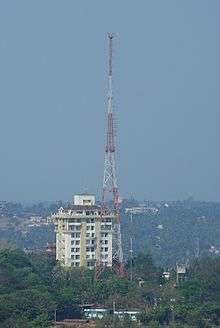
The first ever newspaper in Kannada "Mangalooru Samachara" was brought out by Rev. Hermann Friedrich Mögling of the Basel mission in 1843.[183][184] The first ever Kannada to English dictionary was published in Mangalore by Ferdinand Kittel in 1894.[185] Major national English language newspapers such as Times of India, The Hindu, The New Indian Express and Deccan Herald publish localised Mangalore editions. The Madipu, Mogaveera, Samparka (Contact) and Saphala (Fulfillment) are well-known Tulu periodicals in Mangalore.[186] Popular Konkani language periodicals published in the city are Raknno (Guardian), Konknni Dirvem (Konkani Treasure), and Kannik (Offering). Beary periodicals like Jyothi (Light) and Swatantra Bharata (Independent India) are also published from Mangalore. Among Kannada newspapers, Udayavani (Morning Voice), Vijaya Karnataka (Victory of Karnataka), Prajavani (Voice of the People), Kannada Prabha and Varthabharathi (Indian News) are popular. Evening newspapers such as Karavali Ale (Waves from the Coast), Mangalooru Mitra (Friend of Mangalore), Sanjevani (Evening Voice), and Jayakirana (Rays of Victory) are also published in the city. The Konkani language newspaper kodial Khabbar is released fortnightly.
The state run, nationally broadcast Doordarshan provides both national and localised television coverage. Cable television also provides broadcast cable channels of independently owned private networks. Canara TV transmits daily video news channels from Mangalore.[187] Mangalore is not covered by the Conditional access system (CAS); however, a proposal to provide CAS to television viewers in Mangalore sometime in the future has been initiated by V4 Media, the local cable service provider.[188] Direct-to-Home (DTH) services are available in Mangalore via Dish TV, Tata Sky, Sun Direct DTH, Airtel digital TV, Reliance BIG TV and Videocon D2h .[189] All India Radio (AIR) has a studio at Kadri (with frequency 100.3 MHz) that airs program during scheduled hours. Mangalore's private FM stations include Radio Mirchi 98.3 FM, Big 92.7 FM[190] and Red 93.5 FM.[191] Radio SARANG 107.8 is a community radio run by St. Aloysius College (Autonomous), Mangalore
There are multiple local TV channels which telecast programmes, news in Tulu, Konkani, Beary and Kannada. Namma TV, V4 News, Spandana, Daijiworld are few of the successful TV channels. Namma Kudla,[192] Posa Kural[193] are the Tulu channels dedicated to Tulu programs.
Bale Telipaale is a Tulu comedy based reality show telecasted in Namma TV which is one of the successful Tulu program to be ever telecasted.[194]
Mangalore is home to the Tulu Film Industry, which releases one film per month, on average. Popular Tulu films include Kadala Mage (Son of the Sea) and Suddha (The Cleansing Rites). Tulu dramas, mostly played in the Town Hall at Hampankatta, are very popular.[138] In 2006, a Tulu film festival was organised in Mangalore.[195] Tulu Cinemotsava 2015 was organized in January, 2015.[196] 93.5 Red FM organised Tulu film awards twice from 2014 and 2016
Utility services
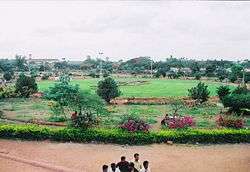
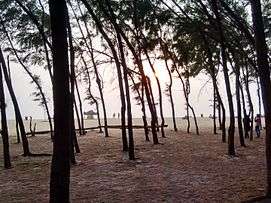
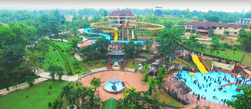
Electricity in Mangalore is regulated by the Karnataka Power Transmission Corporation Limited (KPTCL) and distributed through Mangalore Electricity Supply Company (MESCOM).[197][198][199] Mangalore experiences scheduled and unscheduled power cuts, especially during the summer, due to excess consumption demands.[200] Major industries like Mangalore Refinery and Petrochemicals (MRPL) and Mangalore Chemicals & Fertilizers (MCF) operate their own captive power plants.[201][202]
Potable water to the city is supplied by Mangalore City Corporation.[203] Almost all water is from the vented dam constructed across the Netravati River at Thumbe, 14 kilometres (9 mi) from Mangalore.[204][205] The Karnataka Urban Development and Coastal Environment Management Project (KUDCEMP) aim to improve safe water supply systems and reduce leakage and losses in the distribution system in Mangalore.[203] The official garbage dumping ground of Mangalore is in Vamanjoor.[206] The city generates an average of 175 tons per day of waste, which is handled by the health department of the Mangalore City Corporation.[207] The city has developed and maintains public parks such as Pilikula Nisargadhama,[208] Kadri Park at Kadri, Tagore Park at Light House Hill, Gandhi Park at Gandhinagar,[209] and Corporation Bank Park at Nehru Maidan. Pilikula comprises the zoo, botanical garden, lake, water park(Manasa) and a golf course(Pilikula golf course) which is set in an area of 35 acres.[210]
Fixed Line telecom services are offered alongside GSM and Code division multiple access (CDMA) mobile services. Mangalore is the headquarters of the Dakshina Kannada Telecom District, the second largest telecom district in Karnataka.[211] Prominent broadband internet service providers in the city include Tata indicom, Airtel and DataOne by BSNL.[212] Bharti Airtel, Vodafone India, Reliance Jio and Idea Cellular[213] have launched 4G LTE service in the city.
Cuisine
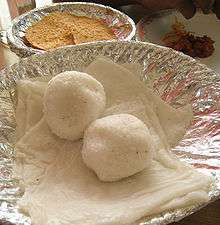
Main Article: Mangalorean Cuisine
Mangalorean cuisine is largely influenced by the South Indian cuisine, with several cuisines being unique to the diverse communities of the region. Coconut and curry leaves are common ingredients to most Mangalorean curry, as are ginger, garlic and chili. Well-known Mangalorean dishes include Kori Rotti , Neer dosa, Pundi, Patrode, Mangalore Buns, Mangalore bajji etc[214][215]. Mangalorean Cuisine is also known for Fish and chicken dishes like Bangude Pulimunchi (spicy sour silver-grey mackerels), Boothai Gasi(Sardine Semi-Gravy) , Anjal fry, Mangalorean Chicken Sukka, Kori rotti, Chicken Ghee Roast etc. Since Mangalore is a coastal city, fish forms the staple diet of most people.[216] The Konkani community's specialities include Daali thoy, bibbe-upkari (cashew based), val val, avnas ambe sasam, Kadgi chakko, paagila podi, and chane gashi.[217] Mangalorean Catholics' Sanna-Dukra Maas (Sanna—idli fluffed with toddy or yeast; Dukra Maas—Pork), Pork Bafat, Sorpotel and the Mutton Biryani of the Muslims are well-known dishes. Pickles such as happala, sandige and puli munchi are unique to Mangalore. Shendi (toddy), a country liquor prepared from coconut flower sap, is popular.[119] Vegetarian cuisine in Mangalore, also known as Udupi cuisine, is known and liked throughout the state and region.
Tourism
The city is called the Gateway of Karnataka[218] and lies between the Arabian Sea and the Western Ghats.[219] The various temples and buildings in Mangalore include the Mangaladevi temple, Kadri Manjunatha temple, St Aloysius Chapel, the Rosario Cathedral, Milagres Church and the Jama Masjid.[220]
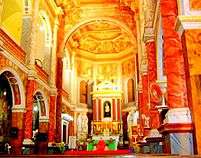
The city is also known for the beach, sun and the golden sands,[221] there are beaches like Panambur, Tannirbavi, NITK beach, Someshwara, Ullal beach, Summer Sands, Kotekar beach and Sasihithlu beach.[222] Panambur and Thannirbhavi beaches attract tourists from across the country.[223] Panambur beach has many facilities including Jet ski rides, Boating, Dolphin viewing,[224] Food stalls, besides Trained Beach Lifeguards and Patrol vehicles to ensure the safety of the visitors.[225] Saavira Kambada Basadi is situated 34 km (21 mi) northeast of Mangalore in the town of Moodabidri.[226] Cruise ships from Europe and the UAE arrive at New Mangalore Port during the winter months to promote tourism around Mangalore.[227][228] The Sultan Battery watch tower, built by Tipu Sultan, situated in Boloor is on the banks of Gurupura River where one can take the ferry ride by paying small amount across the river and reach Tannirbhavi Beach.[229] Manasa Amusement & Water Park, Pilikula Theme Park are located at Vamanjoor. Adyar waterfalls is at the outskirts at about 12 km (7.5 mi) drive from the city.[230]
Mangalore Dasara, a ten-day festival at Sri Gokarnatheswara temple attracts devotees from various states of India who visit Mangalore to witness Dasara.[231] Mangaladevi temple is yet another temple which attracts devotees from all over India during Navaratri.[232]
Geographic location
 |
Udupi | Chikmagalur |  | |
| Arabian Sea | |
Hassan | ||
| ||||
| | ||||
| Kasaragod (Kerala) | Madikeri |
Sister cities
Mangalore is twinned with two Canadian cities:
|
See also
- List of tallest buildings in Mangalore
- List of shopping malls in Mangalore
- List of beaches near Mangalore
- Dakshina Kannada
- Udupi
- Manipal
- Mangalore International Airport
- New Mangalore Port
- Coastal Karnataka
Notes
- 1 2 "Mangalore City Population Census 2011 - Karnataka". Retrieved 7 November 2016.
- ↑ "Mangalore Metropolitan Urban Region Population 2011 Census". Retrieved 7 November 2016.
- ↑ "Pincode Locator Tool". PINcode.Net.In. Retrieved 16 December 2011.
- 1 2 "Human Development Index: DC exhorts officials to aim high". The Hindu. Retrieved 18 February 2016.
- ↑ "Cities having population 1 lakh and above, Census 2011" (PDF). censusindia.gov.in. Retrieved 4 October 2015.
- ↑ "Mangalore to Mangaluru likely". The Hindu. Retrieved 6 May 2016.
- ↑ "Mangalore is Mangaluru". Weekend Leader. Retrieved 6 May 2016.
- 1 2 3 4 "Mangalore takes over as the new SEZ destination". The Economic Times. The Times of India. 17 February 2008. Archived from the original on 15 March 2012. Retrieved 20 March 2008.
- 1 2 "States Reorganisation Act 1956". Commonwealth Legal Information Institute. Archived from the original on 16 May 2008. Retrieved 1 July 2008.
- ↑ Babu, Savitha Suresh (17 February 2007). "Tiles for style". The Hindu. Archived from the original on 12 March 2012. Retrieved 5 April 2008.
- ↑ "Mangalore second cleanest city in State". The Hindu. 25 January 2011. Retrieved 17 June 2015.
- ↑ "Central Pollution Control Board (CPCB) - National Ambient Air Quality Status and Trends - 2012" (PDF). CPCB. August 2014. Retrieved 7 February 2016.
- ↑ "Air Pollution and Health" (PDF). The Energy and Resources Institute (2015). 2015. Retrieved 7 February 2016.
- ↑ "Mangaluru 3rd cleanest city in country". The Hindu. 2016. Retrieved 6 July 2016.
- ↑ "Mangalore at 13th place". News Digest. Retrieved 5 May 2016.
- ↑ "Mangaluru among 6 cities recommended by State for 'Smart Cities' scheme". The Hindu. Retrieved 26 September 2016.
- ↑ Kameshwar, G. (2004). Tulu tales: a soota chronicle. Rupa & Co. p. 8. ISBN 978-81-291-0427-4.
- ↑ Sadasivan, S.N. (2000). A social history of India. New Delhi: APH Pub. Corp. pp. 207–208. ISBN 81-7648-170-X.
- ↑ Venkataraya Narayan Kudva (1972). History of the Dakshinatya Saraswats. Samyukta Gowda Saraswata Sabha. p. 260.
- ↑ Temple India. Vivekananda Prakashan Kendra. 1981. p. 160.
- ↑ "New names invoke a hoary past". The Times of India. 2014-10-19. Retrieved 2015-02-23.
- 1 2 Raghuram, M. (18 July 2007). "Mangaluru: it has come a long way". The Hindu. Archived from the original on 19 March 2012. Retrieved 27 July 2008.
- 1 2 Farias, Kranti K. (1999). The Christian Impact on South Kanara. Church History Association of India.
- ↑ "1652 Sanson Map of India". Retrieved 19 March 2012.
- ↑ "Filled with lore". The Hindu. 2008-06-09. Retrieved 2015-02-23.
- ↑ Bostock, John (1855). "26 (Voyages to India)". Pliny the Elder, The Natural History. London: Taylor and Francis.
- ↑ Prasad, Om P. (1989). Decay and Revival of Urban Centres in Medieval South India: (c. A.D. 600–1200). Volume 4 of Series in Indian history, art, and culture. Commonwealth Publishers. p. 163. ISBN 9788171690060.
- ↑ Indicopleustes, Cosmas (1897). Christian Topography. 11. United Kingdom: The Tertullian Project. pp. 358–373.
- ↑ Das, Santosh Kumar (2006). The Economic History of Ancient India. Genesis Publishing Pvt Ltd. p. 301. ISBN 9788130704234.
- ↑ "Worst-Case Scenario". The Times of India. 30 November 2006. Archived from the original on 17 March 2012. Retrieved 25 August 2008.
- ↑ Kunal Bhatia (26 February 2008). "Mangalore: Of cultural institutions, tiles and religious spots". Mumbai Mirror. Archived from the original on 19 March 2012. Retrieved 25 August 2008.
- 1 2 3 4 5 6 Gavin Shatkin (14 August 2013). "Chapter 10 : Planning Mangalore: Garbage Collection in a Small Indian City". Contesting the Indian City: Global Visions and the Politics of the Local. John Wiley & Sons. ISBN 978-1-118-29584-7.
- ↑ Fedrick Sunil Kumar N.I (2006). "Chapter 6 : The Basel Mission in South Canara". The basel mission and social change-Malabar and south canara a case study (1830–1956)" (PDF) (Ph.D.). University of Calicut.
- ↑ K. Puttaswamaiah (1980). Economic Development of Karnataka: A Treatise in Continuity and Change. Oxford & IBH. p. 33.
- 1 2 3 4 5 6 7 Bhat, N. Shyam (1998). South Kanara, 1799–1860: a study in colonial administration and regional response. Mittal Publications. ISBN 978-81-7099-586-9.
- ↑ Ghosh 2002, p. 189
- ↑ Lee 1829, Perils and detours in Malabar
- 1 2 A. Wahab Doddamane (1993). Muslims in Dakshina Kannada: A Historical Study up to 1947 and Survey of Recent Developments. Green Words Publication.
- ↑ Kamath, J. (16 September 2002). "Where rocks tell a tale". The Hindu Business Line. Archived from the original on 1 March 2012. Retrieved 8 July 2008.
- ↑ Muthanna, I. M. (1977). Karnataka, History, Administration & Culture. Lotus Printers. p. 235.
- ↑ South Kanara District Gazetteer 1973, p. 62
- ↑ Thornton 1859, p. 114
- ↑ Thornton 1859, p. 170
- ↑ Lal 2002, p. 22
- ↑ Forrest 1887, pp. 314–316
- ↑ Townsend 1867, p. 628
- ↑ Riddick 2006, p. 28
- 1 2 Prabhu 1999, p. 152
- ↑ Raghuram, M. (18 June 2005). "Feeling on top of the world". The Hindu. Archived from the original on 15 March 2012. Retrieved 22 August 2008.
- 1 2 N. Shyam Bhat (2001). Judiciary and Police in Early Colonial South Kanara, 1799–1862. Mittal Publications. ISBN 978-81-7099-820-4.
- ↑ Monteiro, John B (2014-01-08). "Last of Italian Jesuits in Mangalore dies in his homeland". Daijiworld Media. Retrieved 2015-03-01.
- 1 2 "Mangalore was once the starting point of India's longest rail route". The Hindu. 29 October 2007. Archived from the original on 15 March 2012. Retrieved 19 March 2008.
- ↑ South Kanara District Gazetteer. Karnataka State Gazetteer. 12. Gazetteer Department (Government of Karnataka). 1973.
- ↑ Damodar Panda (1991). Cargo Handling in the Major Ports of India. Minerva Associates (Publications). p. 30. ISBN 978-81-85195-33-9.
- ↑ Sharma, Ravi. "Industrial leap". Frontline. The Hindu. 24 (19 ( Sep. 22-Oct. 05, 2007)). Retrieved 2015-03-01.
- ↑ "Mangalore, India Page". Falling Rain Genomics, Inc. Retrieved 19 March 2008.
- ↑ "Rainfall Stations in India". Indian Institute of Tropical Meteorology (Pune). Archived from the original on 20 October 2010. Retrieved 27 July 2008.
- 1 2 Rao, P. S. N. Urban governance and management: Indian initiatives. Indian Institute of Public Administration in association with Kanishka Publishers, Distributors. p. 402. ISBN 978-81-7391-801-8.
- ↑ "City Statistics". Mangalore City Corporation. Archived from the original on 1 July 2007. Retrieved 3 August 2007.
- ↑ Balakrishna, K. M.; Narayana, Y; Kumari, Anitha. "Meteorological Measurements of Mangalore Region for ARMEX Programme (Observations and Data Analysis)" (PDF). Department of Physics (Mangalore University): 26. Archived from the original (PDF) on 10 April 2008. Retrieved 25 March 2008.
- ↑ Mausam: quarterly journal of meteorology, hydrology & geophysics, Volume 56, Issue 1. India Meteorological Department. 2005. p. 76.
- ↑ Seismic zoning map of India (Map). Geological Survey of India. Retrieved 20 July 2008.
- ↑ Heitzman 2008, p. 102
- ↑ Mangalore City Corporation, p. 38
- ↑ Subrahmanyam, V. P. "Some aspects of water balance in the tropical monsoon climates of India" (PDF). Hydrology of Humid Tropical Regions with Particular Reference to the Hydrological Effects of Agriculture and Forestry Practice (Proceedings of the Hamburg Symposium, August 1983). International Association of Hydrological Sciences (IAHS). 140: 327–328. Retrieved 8 July 2008.
- ↑ "IMD – Monthly mean maximum & minimum temperature and total rainfall based upon 1901 – 2000 data (Page 42)" (PDF). India Meteorological Department. Retrieved 11 December 2014.
- ↑ "World Weather Information Service – Climatological Information for Mangalore, India". World Meteorological Organization. Retrieved 30 January 2015.
- 1 2 Shrihari 2007, pp. 5–6
- ↑ "Mangalore, India". Weatherbase. Retrieved 19 March 2008.
- ↑ "Mangalore: Temperature in coast never touched 40° C – IMD". Daijiworld. 20 Mar 2014. Retrieved 27 Sep 2015.
- ↑ "Ever Recorded Maximum Temperature, Minimum Temperature and 24 Hours Heaviest Rainfall up to 2010" (PDF). IMD, Inc. Retrieved 24 Dec 2014.
- 1 2 "Weather services to Karnataka state delivered by IMD" (PDF). IMD, Inc. Retrieved 17 March 2016.
- ↑ "Western Ghats (sub cluster nomination)". UNESCO World Heritage Centre. Retrieved 27 July 2008.
- ↑ Mishra, A. K.; Gnanaseelan, C.; Seetaramayya, P. (25 August 2004). "A study of rainfall along the west coast of India in relation to low level jet and air–sea interactions over the Arabian Sea" (PDF). Current Science. Current Science Association. 87 (4): 483. Retrieved 21 March 2008.
- ↑ "TuTiempo – Mangalore climate from 1973–2014". Tutiempo. Retrieved 27 December 2014.
- ↑ "IMD – Monthly mean maximum & minimum temperature and total rainfall based upon 1901 – 2000 data" (PDF). India Meteorological Department. Retrieved 24 December 2014.
- ↑ "Average humidity over the year for Mangalore,India". Weather-And-Climate. Retrieved 11 December 2014.
- ↑ "Average monthly hours of sunshine over the year for Mangalore,India". Weather-And-Climate. Retrieved January 30, 2015.
- 1 2 3 4 "South Scan (Mangalore, Karnataka)". CMP Media LLC. Archived from the original on 7 February 2012. Retrieved 20 March 2008.
- ↑ Directorate of Economics and Statistics (Government of Karnataka) 2005, p. 1
- ↑ "Commissionerate of Customs — Mangaluru". Mangalore Customs. Retrieved 23 July 2008.
- ↑ "Kerala's timber market sustained by imports". Hindustan Times. 17 February 2008. Retrieved 4 April 2008.
- ↑ "Study Area around SEZ, Mangalore". Mangalore City Corporation. Archived from the original (DOC) on 3 October 2008. Retrieved 2 July 2008.
- ↑ Mangalore City Corporation. "Proposed MSEZ Site and Existing Industries". Archived from the original (DOC) on 10 April 2008. Retrieved 9 April 2008.
- ↑ "Two more plans for EPIP cleared". The Hindu. 31 August 2006. Archived from the original on 15 March 2012. Retrieved 29 September 2006.
- ↑ "Perform Group | Mangalore Visit".
- ↑ "Strategic oil reserves to come directly under Govt". The Hindu Business Line. 2 April 2006. Archived from the original on 7 February 2012. Retrieved 20 February 2008.
- ↑ "Strategic crude reserve gets nod". The Hindu. 7 January 2006. Archived from the original on 7 February 2012. Retrieved 20 February 2008.
- ↑ "'India to form crude oil reserve of 5 mmt'". The Economic Times. 20 June 2007. Archived from the original on 7 February 2012. Retrieved 20 February 2008.
- ↑ "'India receives 1st parcel of Iranian oil for strategic storage'". The Economic Times. 12 October 2016. Retrieved 16 October 2016.
- ↑ "'Strategic storage of crude begins at Mangaluru cavern'". Business Standard. 12 October 2016. Retrieved 16 October 2016.
- ↑ "'India Gets First Iranian Oil Parcel For Emergency Reserves'". NDTV Profit. 12 October 2016. Retrieved 16 October 2016.
- ↑ "CNC India Fund Summary" (PDF). CNC India Fund I Periodical. CNC India Group. 1 (1): 2. Archived from the original (PDF) on 11 March 2012. Retrieved 4 July 2008.
- ↑ "History". Corporation Bank. Retrieved 18 April 2008.
- ↑ "Cheque truncation process from April, says Leeladhar". The Hindu. 20 November 2005. Archived from the original on 14 March 2012. Retrieved 18 April 2008.
- ↑ "Inception". Vijaya Bank. Archived from the original on 17 March 2012. Retrieved 9 July 2008.
- ↑ "History of Karnataka Bank". Karnataka Bank. Archived from the original on 17 March 2012. Retrieved 18 April 2008.
- ↑ "Mangalore: Countdown for MCC Bank Election Begins Amid Blame Games". Daijiworld Media Pvt Ltd Mangalore. 15 March 2008. Archived from the original on 17 March 2012. Retrieved 22 July 2008.
- ↑ "History of SCDCC Bank". SCDCC Bank. Archived from the original on 17 March 2012. Retrieved 24 June 2008.
- ↑ National Council of Applied Economic Research 1961, pp. 6–73
- ↑ Directorate of Economics and Statistics (Government of Karnataka) 2004, p. 233
- ↑ Somerset & Bond Wright, p. 510
- ↑ Somerset & Bond Wright, p. 511
- ↑ Rao, Anupama (30 October 2013). "Greater Mangalore all set to give new look to MCC".
- ↑ "Karnataka's tier II cities miss out on boom". Deccan Herald. 24 October 2011. Archived from the original on 1 March 2012. Retrieved 26 October 2011.
- ↑ "City of Mangalore". Mangalore City Corporation. Archived from the original on 19 March 2012. Retrieved 3 August 2007.
- 1 2 3 4 "Provisional Population Totals, Census of India 2011". Deccan Herald. Retrieved 31 October 2011.
- ↑ "Population of Corporation/CMC/TMC/TP (Population 2001 Census)". Directorate of Municipal Administration, Bangalore. Retrieved 16 April 2008.
- ↑ "Census of India 2001: Data from the 2001 Census, including cities, villages and towns. (Provisional)". Census Commission of India. Archived from the original on 16 June 2004. Retrieved 3 September 2007.
- ↑ Mangalore City Corporation, p. 131
- ↑ "Growing number of slums in Mangalore a cause for concern". The Hindu. 8 April 2006. Archived from the original on 1 March 2012. Retrieved 14 March 2008.
- ↑ "Slums mushrooming in port city". The Hindu. 21 January 2006. Archived from the original on 1 March 2012. Retrieved 14 March 2008.
- ↑ Dayananda, B. (2006). "Crime Review – 2006" (PDF). Dakshina Kannada Police. Archived from the original (PDF) on 26 October 2009. Retrieved 25 July 2008.
- ↑ "Chapter 3 - Profile of the Study Area: Coastal Karnataka" (PDF). Shodhganga. Retrieved 15 October 2016.
- ↑ South Kanara District Gazetteer 1973, p. 93
- ↑ "Mangaluru city police undertakes Beary local language learning skills". The Times of India. 31 July 2016. Retrieved 15 October 2016.
- ↑ Prabhu, Ganesh (10 January 2004). "Enduring art". The Hindu. Archived from the original on 5 February 2012. Retrieved 20 July 2008.
- ↑ Pinto, Stanley G. (26 October 2001). "Human 'tigers' face threat to health". The Times of India. Archived from the original on 5 February 2012. Retrieved 7 December 2007.
- 1 2 3 4 D'Souza, Stephen. "Poem: What's in a Name?". Daijiworld Media Pvt Ltd Mangalore. Archived from the original on 5 February 2012. Retrieved 4 March 2008.
- ↑ "Beary Sahitya Academy set up". The Hindu. 13 October 2007. Archived from the original on 5 February 2012. Retrieved 15 January 2008.
- ↑ "Srimanthi Bai Museum is in a shambles". The Hindu. 7 July 2006. Archived from the original on 5 February 2012. Retrieved 21 January 2008.
- ↑ "Shree Venkatramana Temple (Car Street, Mangalore)". Shree Venkatramana Temple, Mangalore. Retrieved 25 July 2008.
- ↑ Shenoy, Rajanikanth (13 February 2008). "Colourful Kodial Theru". Mangalorean.com. Archived from the original on 5 February 2012. Retrieved 9 July 2008.
- ↑ Monteiro, John B. "Monti Fest Originated at Farangipet – 240 Years Ago!". Daijiworld Media Pvt Ltd Mangalore. Archived from the original on 5 February 2012. Retrieved 11 January 2008.
- ↑ Nayak, Amrita (24 November 2007). "Food for thought". The Hindu. Archived from the original on 5 February 2012. Retrieved 18 January 2008.
- ↑ "'Mosaru Kudike' brings in communal harmony". The Hindu. 28 August 2005. Archived from the original on 5 February 2012. Retrieved 22 February 2008.
- ↑ "Objectives of Karavali Utsav". Karavli Utsav, Mangalore. Archived from the original on 5 February 2012. Retrieved 9 July 2008.
- ↑ "Nagarapanchami Naadige Doddadu". Mangalorean.com. 18 August 2007. Archived from the original on 5 February 2012. Retrieved 28 January 2008.
- ↑ "The Hindu". thehindu.co.in. 10 January 2008.
- ↑ 'Kori Katta' draws maximum crowd Mangalorean.com 14 November 2008
- ↑ "The Hindu". thehindu.co.in. 8 September 2011.
- ↑ "Council Members". Mangalore City Corporation. Retrieved 14 October 2014.
- ↑ Integrated Solid Waste Management Operation & Maintenance report, p. 7
- ↑ "New Assembly constituencies". Daijiworld Media Pvt Ltd Mangalore. 14 July 2007. Archived from the original on 13 April 2012. Retrieved 22 September 2007.
- ↑ "Assembly constituencies proposed by Delimitation Commission". The Hindu. 5 May 2006. Archived from the original on 13 April 2012. Retrieved 22 September 2007.
- ↑ "The Indian Police Service (Fixation of Cadre Strength) Regulations, 1955". Ministry of Personnel, Public Grievances and Pensions. Archived from the original on 16 December 2006. Retrieved 15 April 2007.
- ↑ "'Use Kannada script to teach Tulu now'". The Hindu. 22 June 2005. Archived from the original on 5 February 2012. Retrieved 31 January 2008.
- 1 2 Fernandes, Ronald Anil; Naina J. A.; Hegde, Bhakti V.; Raveendran, Aabha; Padmanabha K. V., Sibanthi; Mayya, Sushma P. (15 August 2007). "Sixty and still enterprising ...". Deccan Herald. Archived from the original on 5 February 2012. Retrieved 1 July 2008.
- ↑ "KVG COLLEGE OF ENGINEERING". Retrieved 7 November 2016.
- ↑ "Alike Educational Institutions - Sri Satya Sai Loka Seva Trust". Retrieved 7 November 2016.
- ↑ Kamila, Raviprasad (1 April 2006). "It's a treasure of books". The Hindu. Archived from the original on 5 February 2012. Retrieved 31 January 2008.
- ↑ "Details of Mangalore University". Mangalore University. Archived from the original on 5 February 2012. Retrieved 21 March 2008.
- ↑ "UGC recognised Universities in Karnataka with NAAC accreditation status". Education Observer. Retrieved 15 February 2014.
- ↑ "Bank finance for Agribusiness:A case study in Dakshina Kannada district" (PDF). Dr. G.V. Joshi. Retrieved 18 June 2015.
- ↑ "Intl services begin at Mangalore airport". The Hindu Business Line. 4 October 2006. Archived from the original on 17 March 2012. Retrieved 21 February 2008.
- ↑ "Special – New National Highway Numbers". Retrieved 10 August 2012.
- ↑ "NH wise Details of NH in respect of Stretches entrusted to NHAI" (PDF). National Highways Authority of India (NHAI). Archived from the original (PDF) on 25 February 2009. Retrieved 4 July 2008.
- ↑ "DK's new NH to connect three states". The Times of India. 26 April 2010. Retrieved 15 December 2011.
- ↑ "4-lane road project in Mangalore likely to be completed in 30 months". The Hindu Business Line. 7 October 2005. Retrieved 13 October 2006.
- ↑ Sastry, Anil Kumar (2015-11-04). "KSRTC city bus services to start running by month-end". The Hindu. ISSN 0971-751X. Retrieved 2016-10-08.
- ↑ "Profile of KSRTC". Karnataka State Road Transport Corporation (KSRTC). Archived from the original on 3 July 2008. Retrieved 4 July 2008.
- ↑ "Transport operators in district vie for routes". The Hindu. 6 March 2006. Retrieved 16 June 2008.
- ↑ "Finally Nurm buses get permit in Mangaluru". Udayavani. 22 August 2015. Retrieved 11 October 2016.
- ↑ "Uber launches operations in Mangaluru". www.daijiworld.com. Retrieved 2016-10-06.
- ↑ Sastry, Anil Kumar (2015-03-06). "Get a cab on call, Ola launches service in Mangaluru". The Hindu. ISSN 0971-751X. Retrieved 2016-10-06.
- ↑ "Name changed". The Hindu. 8 November 2007. Retrieved 5 July 2008.
- ↑ "Mangalore -Hassan rail line open for freight traffic". The Hindu Business Line. 6 May 2006. Retrieved 13 October 2006.
- ↑ "Bangalore-Mangalore train service from December 8". The Hindu. 24 November 2007. Retrieved 2 October 2008.
- ↑ "The Beginning". Konkan Railway Corporation Limited. Retrieved 16 April 2008.
- ↑ "Southern Railway to operate special trains". The Hindu. 23 August 2011. Retrieved 15 December 2011.
- ↑ Integrated Solid Waste Management Operation & Maintenance report, p. 4
- ↑ "New Mangalore Port Trust (NMPT)". New Mangalore Port. Retrieved 13 October 2006.
- ↑ "Minister keen on improving sports infrastructure". The Hindu. 7 August 2006. Retrieved 18 February 2008.
- ↑ "Approval granted for sports training centre at Mangala Stadium". The Hindu. 17 July 2006. Retrieved 25 July 2008.
- ↑ "Central Maidan (Mangalore, India)". Cricinfo. Retrieved 25 July 2008.
- ↑ Vasu, Anand (9 September 2007). "Wadiyar defeats Viswanath in Karnataka elections". Cricinfo. Retrieved 25 July 2008.
- ↑ "Mixed verdict in KSCA polls". Deccan Herald. 10 September 2007. Archived from the original on 5 February 2012. Retrieved 25 July 2008.
- ↑ Network, CD. "Independence Day Cup football tourney concludes on a high note". Coastaldigest.com. Retrieved 2016-10-16.
- ↑ "Recent Tournaments". United Karnataka Chess Association. Archived from the original on 8 May 2008. Retrieved 22 July 2008.
- ↑ "Mangalore: All India Fide Rated Open Chess Tournament takes off". Mangalorean.Com. 3 July 2006. Retrieved 25 July 2008.
- ↑ "All India chess tourney in Mangalore from July 19". Mangalorean.Com. 17 June 2008. Retrieved 25 July 2008.
- ↑ "Details of Pilikula Nisarga Dhama (Pilikula)". Pilikula Nisargadhama. Archived from the original on 5 February 2012. Retrieved 25 July 2008.
- ↑ "Pilikula — Perched for higher growth". Mangalorean.com. 20 July 2008. Archived from the original on 5 February 2012. Retrieved 25 July 2008.
- ↑ "Budhi Kunderan (India)". Cricinfo. Retrieved 26 July 2008.
- ↑ Vasu, Anand (11 March 2007). "Repaying the faith". Cricinfo. Retrieved 25 July 2008.
- ↑ "The first ever Indian Open of Surfing to kick off in Mangalore on 27 May". Sportskeeda. 24 May 2016. Retrieved 28 November 2016.
- ↑ "Surfing Federation of India announces Team India for Fiji ISA World SUP, Paddleboard Championship". The Times of India. 4 November 2016. Retrieved 28 November 2016.
- ↑ Kamila, Raviprasad (2016-01-15). "Kite festival at Panambur beach from today". The Hindu. ISSN 0971-751X. Retrieved 2016-11-26.
- ↑ "Panambur beach all set for Rotary International Kite Festival 2016 - Times of India". The Times of India. Retrieved 2016-11-26.
- ↑ "Kambala | Festivals of Karnataka | Buffalo Race". Karnataka.com. 2015-01-16. Retrieved 2016-10-08.
- ↑ "Colours of the season". The Hindu. 9 December 2006. Archived from the original on 28 April 2012. Retrieved 9 July 2008.
- ↑ Kamila, Raviprasad (2014-11-05). "Pilikula 'kambala' on December 29 in Mangaluru". The Hindu. ISSN 0971-751X. Retrieved 2016-10-08.
- ↑ S, Bageshree (2015-10-06). "First Kannada newspaper was brought out by a German". The Hindu. ISSN 0971-751X. Retrieved 2016-10-29.
- ↑ "Herr Kannada". Deccan Herald. 18 January 2004. Archived from the original on 5 February 2012. Retrieved 18 January 2008.
- ↑ "A grammar of the Kannada language in English : comprising the three dialects of the language". Mangalore : Basel Mission Book and Tract Depository. Retrieved 22 November 2016.
- ↑ "'Madipu' literary competitions". Deccan Herald. 19 July 2007. Archived from the original on 5 February 2012. Retrieved 18 January 2008.
- ↑ "Daily Video News Channels from Mangalore". Canara Tv. Retrieved 16 January 2008.
- ↑ "Mangalore: Channel V4 to offer Conditional Access System". Mangalorean.com. 22 December 2007. Archived from the original on 5 February 2012. Retrieved 24 January 2008.
- ↑ "Good response for DTH in Mangalore". The Hindu. 19 March 2005. Archived from the original on 5 February 2012. Retrieved 21 January 2008.
- ↑ "BIG FM Launches Station in Mangalore". Media Newsline. 5 December 2007. Archived from the original on 5 February 2012. Retrieved 5 July 2008.
- ↑ Belgaumkar, Govind D. (23 November 2007). "It's time to swing to hits from FM channels". The Hindu. Archived from the original on 5 February 2012. Retrieved 5 July 2008.
- ↑ "Nammakudla News". www.nammakudlanews.com. Retrieved 2016-10-06.
- ↑ "Posa Kural decennial: Real Time News and Latest Updates". Posa Kural decennial: Real Time News and Latest Updates.
- ↑ "Bale Telipaale Archives - Tulunadu News". Tulunadu News. Retrieved 2016-10-06.
- ↑ "Tulu film festival". The Hindu. 23 February 2006. Archived from the original on 5 February 2012. Retrieved 19 January 2008.
- ↑ "Konkanworld | Tulu Cinemotsava 2015". www.konkanworld.com. Retrieved 2016-11-12.
- ↑ "About Us". Karnataka Power Transmission Corporation Limited (KPTCL). Retrieved 3 July 2008.
- ↑ "About Us". Mangalore Electricity Supply Company (MESCOM). Retrieved 3 April 2008.
- ↑ Directorate of Economics and Statistics (Government of Karnataka) 2004, p. 227
- ↑ "Unscheduled load-shedding may be inevitable: Mescom". The Hindu Business Line. 5 February 2003. Archived from the original on 17 March 2012. Retrieved 3 July 2008.
- ↑ "Mangalore Refinery and Petrochemicals Ltd. (A Subsidiary of Oil and Natural gas Corporation Ltd.)" (PDF). Mangalore Refinery and Petrochemicals (MRPL). Retrieved 3 July 2008.
- ↑ "Infrastructure". Mangalore Chemicals & Fertilizers (MCF). Archived from the original on 11 October 2007. Retrieved 3 July 2008.
- 1 2 Budhya, Gururaja. "'Social relevance of decision making' – A case study of water supply and waste water management in Mangalore, Coastal Karnataka, India." (PDF). Asian Educational Services: 1–2. Archived from the original (PDF) on 27 February 2008. Retrieved 18 February 2008.
- ↑ "No funds crunch to tackle water scarcity in Dakshina Kannada". The Hindu Business Line. 21 April 2005. Archived from the original on 17 March 2012. Retrieved 5 April 2008.
- ↑ "Karnataka Coastal Project" (PDF) (October–December 2004). Duraline Pipes: 1. Retrieved 27 July 2008.
- ↑ "Vamanjoor dumpyard turns killer". The Times of India. 8 December 2002. Archived from the original on 5 February 2012. Retrieved 16 April 2008.
- ↑ Mangalore City Corporation, p. 10
- ↑ "About Place". PUlikula Nisargadhama. Retrieved 3 July 2008.
- ↑ Pinto, Stanly (7 September 2003). "Gandhi Nagar park gets a new lease of life". The Times of India. Archived from the original on 14 March 2012. Retrieved 26 March 2008.
- ↑ "The Times of India - Pilikula". The Times of India. Retrieved 27 October 2016.
- ↑ "South Kannada Telecom District". Bharat Sanchar Nigam Limited (Karnataka Telecom Circle). Archived from the original on 15 July 2007. Retrieved 15 March 2008.
- ↑ "BSNL launches broadband service". The Hindu. 17 June 2005. Archived from the original on 13 March 2012. Retrieved 22 February 2008.
- ↑ "Idea Cellular – Cell Phone Services |3G, Prepaid, Postpaid & Wireless Internet". www.ideacellular.com. Retrieved 2016-11-12.
- ↑ "Mangalorean Recipes Archives - Indian food recipes - Food and cooking blog". Indian food recipes - Food and cooking blog. Retrieved 2016-11-01.
- ↑ "RCI: Udupi & Mangalorean Cuisine Round-up". Monsoon Spice | Unveil the Magic of Spices... 2009-10-14. Retrieved 2016-11-01.
- ↑ "Typically home". The Hindu. 11 August 2007. Archived from the original on 5 February 2012. Retrieved 9 July 2008.
- ↑ "Have you had these seven iconic Mangalore dishes?". The Indian Express. 2016-04-18. Retrieved 2016-11-01.
- ↑ "Mangalore Diary: Highrises, malls & beautiful Bunt women". CNN-News18. Retrieved 2016-12-03.
- ↑ http://www.emergingplanet.com/. "Mangalore - Karnataka India -mangalore-karnataka.com". www.mangalore-karnataka.com. Retrieved 2016-12-01.
- ↑ "Top 6 Tourist Attractions In Mangalore". Trans India Travels. Retrieved 2016-12-01.
- ↑ "Ullal Beach | Mangalore Beach". Karnataka.com. 2011-12-02. Retrieved 2016-12-01.
- ↑ "Virgin Sasihithlu beach beckons tourists". The Hindu. Retrieved 2016-12-03.
- ↑ "Tannirbhavi beach gets a new look". Deccan Herald. Retrieved 2016-12-03.
- ↑ "Mangalore: Dolphin Sighting Turns Panambur Beach More Adventurous". Daijiworld. Retrieved 2016-12-03.
- ↑ "Adventure sports hotting up along Mangalore coast". The Times of India. Retrieved 2016-12-03.
- ↑ "Saavira Kambada Basadi | Jain Temples in Karnataka | Moodabidri". Karnataka.com. 2014-01-31. Retrieved 2016-12-01.
- ↑ "Nautica and Norwegian Star cruise through M'luru coast". Deccan Herald. Retrieved 2016-12-03.
- ↑ "Aida Aura arrives in Mangaluru". Deccan Chronicle. Retrieved 2016-12-03.
- ↑ "Sultan Battery, Sultan Battery Mangalore, Sultan Battery History". www.mangaluruonline.in. Retrieved 2016-12-01.
- ↑ "Weekend getaway: Plan a day's outing to Adyar waterfalls". www.daijiworld.com. Retrieved 2016-12-01.
- ↑ "City spruced up for Mangaluru Dasara". The Hindu. Retrieved 2016-12-03.
- ↑ "Mangalore Dasara culminates in grand cultural cavalcade". www.daijiworld.com. Retrieved 2016-12-01.
- ↑ "Hamilton's Twin Cities". The Hamilton Mundialization Committee. Retrieved 19 January 2015.
- ↑ "Mangalore, Delta in sisterly embrace". DNA India. Retrieved 19 January 2015.
References
- Chopra, P. N. (2003). History of South India. S.Chand & Company. ISBN 81-219-0153-7. Retrieved 2 July 2008.
- Census of India, 1971. Office of the Registrar General (Government of India).
- Directorate of Economics and Statistics (Government of Karnataka) (2004). "Economic Infrastructure". Economic Survey of Karnataka 2003–04 (PDF). National Informatics Centre (Karnataka State). pp. 216–235. Retrieved 25 July 2008.
- Directorate of Economics and Statistics (Government of Karnataka) (2005). Area, Population, Membership, Revenue, Expenditure & Employment by Municipalities, Karnataka, 2000–2001. (PDF). National Informatics Centre (Karnataka State). Retrieved 26 July 2008.
- Dodwell, H.H. (1922). The Cambridge History of India. Cambridge University Press Archive. Retrieved 16 January 2009.
- Fisher, William Bayne; Jackson, Peter; Lockhart, Laurence (1986). The Cambridge history of Iran. Cambridge University Press. ISBN 978-0-521-20094-3. Retrieved 6 June 2009.
- Forrest, George W. (1887). Selections from the Letters, Despatches, and Other State Papers Preserved in the Bombay Secretariat. 2. Bombay: Government Central Press.
- Ghosh, Amitav (2002). The Imam and the Indian: Prose Pieces. Orient Longman. ISBN 81-7530-047-7. Retrieved 2 July 2008.
- Heitzman, James (2008). City in South Asia (illustrated ed.). Routledge. ISBN 978-0-415-34355-8. Retrieved 6 June 2009.
- "History". South Kanara District Gazetteer. Karnataka State Gazetteer. 12. Gazetteer Department (Government of Karnataka). 1973. pp. 33–85.
- International Committee of Historical Sciences (1935). Bulletin of the International Committee of Historical Sciences. 7. Les presses universitaires de France.
- Kerr, Robert (1812). "Discoveries, Navigations, and Conquests of the Portuguese in India, from 1505 to 1539". General History and Collection of Voyages and Travels. 6. George Ramsay and Company. Retrieved 21 July 2008.
- Mangalore City Corporation. "Description of Environment". Mangalore SEZ Draft (October 2007) (DOC). pp. 31–48. Retrieved 21 March 2008.
- Mangalore City Corporation. "Description of Environment". Mangalore SEZ Draft (October 2007). pp. 111–134. Archived from the original (DOC) on 10 April 2008. Retrieved 9 April 2008.
- Lal, K. S. (2002). Return to roots: emancipation of Indian Muslims. Radha Publications. ISBN 978-81-7487-245-6..
- Lee, Samuel (1829). "On the Malabar Coast". Quoted in "Selections from the Travels of Ibn Batuta". London: Oriental Translation Committee. Retrieved 29 July 2008.
- Mangalore City Corporation. Integrated Solid Waste Management Operation & Maintenance report. Archived from the original (DOC) on 10 April 2008. Retrieved 20 June 2008.
- National Council of Applied Economic Research (1961). Traffic Survey of Mangalore and Malpe Ports: Report. Public Works Department, Government of Mysore.
- Pinto, Pius Fidelis (1999). "History of Christians in coastal Karnataka, 1500–1763 A.D.". Mangalore: Samanvaya Prakashan..
- Prabhu, Alan Machado (1999). Sarasvati's Children: A History of the Mangalorean Christians. I.J.A. Publications. ISBN 978-81-86778-25-8..
- "People". South Kanara District Gazetteer. Karnataka State Gazetteer. 12. Gazetteer Department (Government of Karnataka). 1973. pp. 86–125.
- Riddick, John F. (2006). The History of British India: A Chronology. Greenwood Publishing Group. ISBN 0-313-32280-5. Retrieved 2 July 2008.
- Shrihari, S. (2007). Environmental Concerns for a Typical Fast Developing Indian City: Mangalore. Faculty of Civil Engineering, National Institute of Technology Karnataka, Surathkal.
- Somerset, Playne; Bond, E. W.; Wright, Arnold; Wright, Playne (2004). Southern India: Its History, People, Commerce, and Industrial Resources. Asian Educational Services. ISBN 81-206-1344-9. Retrieved 18 June 2008.
- Thornton, Edward (1859). The History of the British Empire in India. Cox and Wyman Printers. Retrieved 5 July 2008.
- Townsend, George Henry (1867). A Manual of Dates: A Dictionary of Reference to the Most Important Events in the History of Mankind to be Found in Authentic Records. Warne. Retrieved 19 August 2008.
Further reading
- Bhat, P. Gururaja (1969). Antiquities of South Kanara. Prabhakara Press.
- Hoiberg, Dale; Ramchandani, Indu (2000). "Mangalore". Students' Britannica India. Popular Prakashan. ISBN 0-85229-760-2. Retrieved 16 June 2008.
- Venn, T. W. (1945). Mangalore. Mysore: Wesley Press.
External links
| Wikimedia Commons has media related to Mangalore. |
